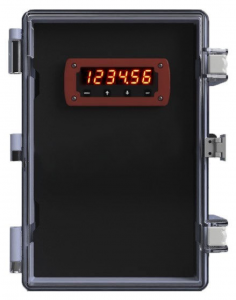July 2017, Vol. 244, No. 7
Features
Advantages of Using Flow Meters to Reduce Pressure Drop
By Dave Grumney, President & CEO, FLO-CORP, Wadsworth, OH
Plant operators rely on plant air pressures to maintain properly working equipment and systems. One common problem affecting processing plants that use compressed air systems is the ability to maintain reliable pressure throughout the distribution system.

Insufficient air pressures may be due to undersized distribution piping, but more commonly the causes are flow restrictions in the distribution system such as filters, check valves and fittings, as well as flow meters and gauges.
Leaks in the distribution system actually rank low as the common cause of pressure drop – the reduction of pressure from the compressor discharge to the actual point of use. The system will appear as if there is a lack of air pressure, but the real problem is pressure drop, which will cause excessive energy consumption. This article explains the causes of pressure drop, a variety of solutions and ultimately how to eliminate costly downtime.
Challenge
Unfortunately, the solution is not as easy as just cranking up the air pressure at the delivery point, as this will cause other issues such as leaks, excessive component wear and maintenance issues. Every pound per square inch (psi) of excess operating pressure increases air compressor power consumption by about 0.5%. As can be seen from the pressure drop formula (Figure 1), increasing the system pressure will actually increase the pressure drop. Unregulated equipment on the system will increase demand and increase inefficiency of the system.
Minimizing pressure drop can be obtained by selecting equipment such as air treatment equipment, filters, dryers, flow metering and instrumentation with the lowest amount of pressure drop. Additional ways to decrease pressure drop include maintaining air filtering and air treatment to reduce moisture that can create corrosion and increase friction on the piping system. Also, reduce the distance air travels through the distribution system to create the shortest runs possible to reduce loss.
Select the correct pipe sizes and pipe material with the effort to stay away from hoses or corrugated products that will reduce pressure. Sizing pipe is critical for efficiency with the goal of keeping air velocities in the distribution header less than 20-30 ft./sec. Increased velocities will increase pressure drop.
The calculation for pressure drop is called the empirical formula:
dp=7.57 q1.85 L104/(d5 p)
Where:
• dp is the pressure drop measured in kg/cm2.
• q is the air volume flow at atmospheric conditions measured in m3/min.
• L represents the length of pipe measured in meters (m).
• d is the inside diameter of pipe measured in millimeters (mm).
• p shows initial absolute pressure in the system measured in (kg/cm2). This is the rating of your compressor, which gives the pressure expected at its outlet valve.
Air-Low Quality
Another big influence on pressure drop has to do with the quality of the air flow. Air that flows in a swirling and turbulent path inside the pipe is called “turbulent flow.” Turbulent flow is the most inefficient flow condition. This is because air molecules spend energy bouncing off of pipe walls in all directions rather than moving down the pipe.
The ideal flow condition is for the air molecules to all move in a straight forward path down the pipe together. This flow condition is called “laminar flow.” Turbulent and laminar flow can be calculated using the following formula to determine what is called the Reynolds number:
Re = ρvd/µ
Where:
Re is the Reynolds number.
ρ is the air density.
v is the mean velocity.
d is the diameter of the pipe.
µ is the dynamic viscosity.
The efficient air flow system should have a Reynolds number of less than 2,300. If the number is greater, the air flow in the pipe will be turbulent and corrections should be made.
Making smart measurements of the compressed air system will reduce maintenance and energy cost as well as ensuring proper operation for all equipment requiring consistent air delivery. The measurement equipment is relatively inexpensive. Monitoring power use, air flow and air pressure is all that is required to ensure a properly working system. Other measurements such as dew point and temperature can also help make your system operate with better results.
By measuring the air flow, pressure and energy use, a baseline of the system operation can be generated. Typical flow data in a compressed air system is measured in cubic feet per minute (cfm). By knowing the volume of air use, system pressure measured in pounds per square inch (psi) and energy use measured in kilowatts per hour (kWh), a baseline of efficiency for the system can be established.
Volumetric flow meters, also called variable area (VA) flow meters, are typically used to measure compressed air because these do not require any straight runs of pipe before or after the meter installation. Also, VA flow meters are unaffected by such phenomena as turbulent flow conditions, which will create inaccurate or no-flow readings in a velocity type of flow meter.
Some volumetric flow meters make accurate readings with differing system pressure by using pressure compensation into a flow monitor. One of the greatest benefits of a VA meter is that it is totally unaffected by water or moisture in the compressed air.
Unlike velocity meters or thermal mass flow meters, volumetric technology is only able to read flow ranges within a 10:1 flow ratio, also known as the “effective flow range” of the flow meter.
Thermal mass flow meters are also an excellent choice for measuring flow in the compressed air line as long as the meter is installed after the air dryer, and the air dryer is functioning properly. Thermal mass meters will typically measure a flow range of 100:1, so they can read very low flow rates, enabling detection of air leaks in the system.
Some thermal mass meters will insert into the pipe and even have hot-tap ability for easy installation without shutting the system flow down for installation. Since there are no moving parts, the meters are easy to maintain, and the flow system, when inserted into the pipe, will provide accurate flow with almost no pressure drop across the flow meter.
Insertion-type thermal mass flow meters can also be used as a portable meter that can measure flows at many different locations by insertion through isolation ports installed throughout the system. The meters will detect velocities well over 30 feet per second (fps) and as low as 0.05 fps.
Reliable Monitoring
When smart metering is implemented, the system optimizes velocity and operating pressure to reduce pressure drop. Typically, a flow meter is used to measure plant demand and not the full load of the compressor output.
The baseline of the operating system can be generated with flow, pressure and electrical load measurements taken on a continual basis through customized meters.
One benefit of using a flexible process meter is that leaks can be easily detected. This happens when the flow reading is indicating something other than zero flow while the plant is not in operation. The pressure trend will also indicate a loss of pressure at a greater rate than historically trended, if the air leaks have increased over time. Logged data can also be analyzed to evaluate system performance and provide predictive maintenance on the compressor head, vanes and lower unit to prevent loss of pressure.
It is possible for the compressor to consume the same amount of energy and even appear to be working properly but not produce any pressure or air flow. These operational and maintenance issues can be reduced by smart metering analytics and system alarming strategies.

Author: Dave Grumney is president and CEO of FLO-CORP, a U.S. manufacturer of flow, level and monitoring instrumentation. He started working in the process instrumentation field over 30 years ago and founded his company, along with his wife, Kathy, in 1989.





Comments